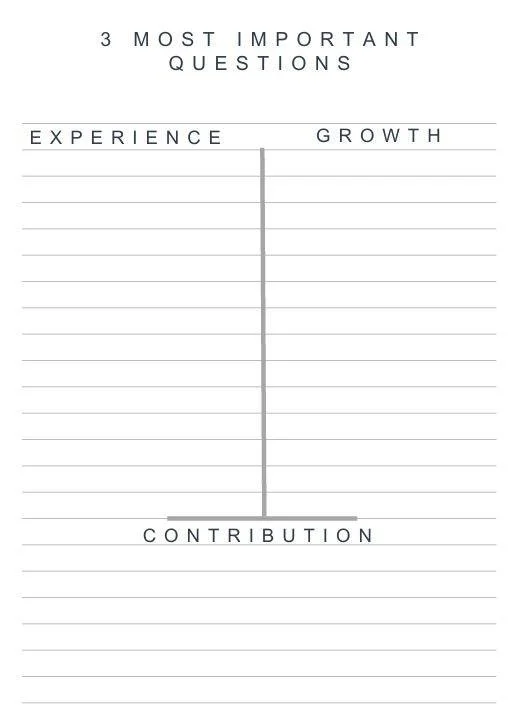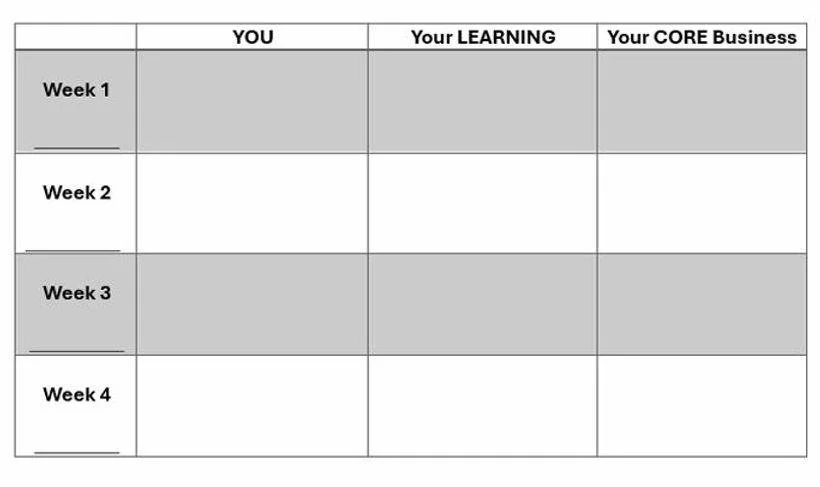Overcoming Overwhelm: 3 Strategies for Educators and Leaders
Written by Victoria Psaltis, Support Unit Coordinator, Guided Growth Coaching
It’s the middle of Term 3.
Whispers begin in the staffroom.
Teachers start speculating about what’s to come—What grade will I have next year? Will I even be at the same school? At first, these murmurs seem harmless, but as the weeks pass, they grow louder. Anxiety ripples through the school, sometimes leading to tears and quiet moments of overwhelm in empty classrooms.
For many educators, this uncertainty feels like a storm cloud looming overhead. The lack of clarity about the future, combined with the usual pressures of teaching, creates a perfect recipe for stress. But it doesn’t have to be this way. By understanding why overwhelm happens and adopting simple, effective strategies, we can take back control and bring calm to the chaos.
Here are three powerful ways to overcome overwhelm—woven through with lessons from those emotional Term 3 whispers.
Overwhelm Hack #1 From LOST to PURPOSE
Create Certainty with End Goals
One of the biggest contributors to overwhelm is uncertainty. As educators, we thrive on structure and plans, so not knowing what’s next—like what class or even which school you’ll be in next year—can leave us feeling untethered.
This is where end goals become your anchor. By focusing on your ultimate vision—what you want to experience, how you want to grow, and how you want to contribute—you can ground yourself, even when the immediate future feels unclear.
I’ll never forget a conversation with a colleague during Term 3. Whispers in the staffroom had turned into an announcement: her role was changing, and she didn’t know how to prepare. She burst into tears, overwhelmed by the uncertainty and the pressure of the unknown. We stepped aside, and I guided her through a simple exercise to reflect on her end goals. These goals weren’t just about her career but also her personal life, values, and aspirations. By the end of the conversation, she felt calmer and more focused, ready to tackle the uncertainty with renewed clarity.
How to Use the 3 Most Important Questions Framework with Your Staff
This simple exercise helps educators clarify what truly matters to them, tapping into their unconscious mind to unlock honest and instinctive answers. Follow these steps to guide your team through the process:
Plan a Dedicated Session - Set aside 15–20 minutes during a staff meeting or professional learning day. Explain that this exercise is designed to provide clarity and purpose, even in uncertain times.
Frame the Questions - Provide a quiet space and ask staff to reflect on the following three questions, giving them 90 seconds per question:
What would you like to experience? (Think about the moments, relationships, or opportunities that bring joy and fulfilment.)
What growth do you want to achieve? (Consider personal development, health, and skills you’d like to build.)
How do you want to contribute? (Reflect on how you’d like to make an impact, either professionally or in your personal life.) Explain that the 90-second limit is intentional—it helps bypass overthinking and taps into the unconscious mind, letting answers flow naturally.
Encourage Reflection - Once the exercise is complete, invite those who feel comfortable to share one insight or takeaway. Emphasise that this activity is flexible—end goals can be tailored to their career or personal life.
Create a Shared Visual Reminder - Ask each staff member to write one key goal from their exercise on a shared poster, board, or space in the staffroom. For example:
"Experience more balance by spending weekends with family."
"Grow my confidence in public speaking."
"Contribute by mentoring a colleague next term."
This creates a visual reminder that everyone is working toward something meaningful and promotes a sense of connection and shared purpose.
Why This Works
The simplicity of this exercise, combined with the short time frame, allows educators to uncover what truly matters without overthinking. By answering instinctively, they access deeper insights into their priorities and values, creating clarity amidst uncertainty.
Displaying these shared goals in a common area fosters a culture of connection and accountability. It reminds staff that they’re not alone in their journey and reinforces the importance of both personal and professional growth.
Just as my colleague found clarity amidst her tears that day, your team can also find direction and confidence—even during times of transition. By revisiting these goals throughout the year, you’ll create a culture of reflection, connection, and growth, ensuring educators feel supported and empowered to thrive.
Tip: Revisit the shared goals at the start of each term. Encourage staff to update their aspirations or share wins related to their goals, reinforcing the culture of connection and continuous improvement.
Overwhelm Hack #2 - Eliminate Overload with Prioritisation:
One of the biggest reasons teachers experience overwhelm is having too many tasks competing for their attention. The demands of lesson planning, marking, meetings, and managing extracurricular activities can make everything feel urgent and important. However, not everything requires immediate focus—or even needs to be done at all.
This sense of overload becomes particularly evident when educators are responsible for organising large school events. Whether it is a graduation, a student showcase, or a whole-school celebration, these occasions are meant to be moments of joy and community connection. Yet, for many teachers, the sheer scale of the planning and logistics quickly turns into a source of stress.
As deadlines approach, the pressure intensifies. Staff members stay late, work through their breaks, and struggle to balance event planning with their everyday teaching responsibilities. The weight of the workload begins to take its toll, with teachers finding it difficult to prioritise tasks effectively. Conversations shift from excitement to anxiety, as concerns about timing, organisation, and capacity take centre stage.
“How will we get this done?” “There’s just too much to do!”
With an overwhelming number of responsibilities, decision fatigue sets in, making it difficult to focus or take meaningful action. Without a clear plan to break down the workload into manageable steps, the process can become mentally and physically exhausting, leaving teachers feeling stuck and unable to function at their best.
Introducing the Eisenhower Matrix—a tool that transforms the chaos into clarity.
What is the Eisenhower Matrix?
The Eisenhower Matrix is a simple framework for categorising tasks based on urgency and importance. It helps you quickly identify what needs your attention and what can be scheduled, delegated, or eliminated altogether.
It’s best used as a weekly planning tool, either for professional or personal tasks. I always recommend laminating the matrix and placing it somewhere visible—above your desk or on the fridge—so it becomes part of your routine.
How to Use the Eisenhower Matrix
Here’s a step-by-step guide to implementing the Eisenhower Matrix:
Start with a Brain Dump - The first step is to get everything out of your head. Grab a piece of paper and write down every single task you can think of—big or small. The key here is to release all the mental clutter. This process alone can feel like a weight lifting off your shoulders. During the school-wide event planning, I encouraged each teacher to brain dump their to-dos into their diary. The tasks ranged from “order food for the event” to “create seating arrangements” to “confirm student speeches.” Seeing everything written down made it easier to confront the chaos.
Sort Your Tasks into the Matrix - Once you’ve completed your brain dump, categorise each task into one of four quadrants:
Urgent and Important: These are tasks that need immediate attention, like confirming bookings or sending invites to parents.
Important but Not Urgent: These tasks are crucial but can be scheduled for later, such as preparing decorations or creating thank-you notes.
Urgent but Not Important: These tasks can be delegated. For example, asking parent volunteers to help set up chairs or manage ticket sales.
Neither Urgent nor Important: These are distractions that can be eliminated, like obsessing over minor details that won’t affect the event’s success.
Take Action - With tasks categorised, it’s time to act. Start with the urgent and important tasks, then schedule the important-but-not-urgent ones into your calendar. Delegate anything you don’t need to handle personally, and let go of what doesn’t matter.
During our event planning, teachers quickly realised that tasks like “perfecting the font on invitations” could be eliminated, while tasks like “finalising the schedule” took priority. Delegating some of the logistical work to support staff and parent volunteers freed up valuable time and energy.
The Transformation: From Chaos to Calm
The results were almost immediate. Within a few days, staff members started to express the effect this framework had on their mind as well as the organisation of the event,
“I finally got a good night’s sleep,”
“I didn’t realise how much was in my head until I wrote it all down.”
By using the Eisenhower Matrix, they were able to turn mental chaos into actionable steps. They brain dumped everything they needed to do, prioritised what truly mattered, and let go of unnecessary tasks. The stress that had felt insurmountable was replaced with a sense of control and clarity.
As the big event approached, the atmosphere shifted. Instead of frantic conversations, there was an air of calm confidence. Tasks were completed on time, and the event was a huge success. Teachers who had been overwhelmed just weeks earlier were now able to fully enjoy the moment, knowing they had done everything that truly mattered.
Why It Works
The Eisenhower Matrix works because it forces us to confront the clutter in our minds and take intentional action. By visually categorising tasks, it becomes clear what needs immediate attention and what doesn’t. This structure helps eliminate the mental blocks that come with overwhelm and enables us to focus on what truly matters.
Your Turn
If you’re feeling overwhelmed, try using the Eisenhower Matrix this week:
Brain dump all your tasks—don’t hold back!
Sort them into the four quadrants.
Take action: tackle the urgent and important, schedule the rest, delegate, and let go of what doesn’t serve you.
Then, laminate your matrix and place it somewhere visible to make it a regular part of your routine. Whether it’s for work or personal life, this tool can help you turn chaos into calm and regain a sense of control.
Pro Tip: Encourage your team to do the same. Shared prioritisation creates a culture of clarity and efficiency, helping everyone move forward with confidence.
Overwhelm Hack #3 The 6-Month Plan: Turning Big Initiatives into Manageable Steps
In schools, change is constant. Whether it’s the introduction of new teaching frameworks, curriculum updates, or whole-school initiatives, educators are frequently asked to adapt. Often, these initiatives begin with an inspiring professional learning session and the best of intentions. Educators leave motivated, brimming with ideas, and eager to implement what they’ve learned.
But then reality hits. Between the demands of lesson planning, marking, and managing classrooms, those exciting new initiatives often take a back seat. Without clear direction, next steps, and achievable goals, educators quickly become overwhelmed. What starts as enthusiasm turns into frustration, with staff unsure of how to proceed, where to focus, or even how to measure success.
This is where the 6-Month Plan comes in. By breaking down your overarching initiative into smaller, actionable steps—first into months, and then into weeks—you can ensure that progress remains steady and sustainable.
Why a 6-Month Plan Works
Clarity and Focus: A clear plan transforms vague aspirations into actionable steps. Educators know what they need to do each month and week to stay on track.
Avoiding Overwhelm: Instead of tackling everything at once, the plan helps educators focus on manageable chunks, reducing stress.
Accountability: Regularly tracking progress keeps everyone aligned and motivated.
Celebrating Wins: Breaking the journey into smaller milestones allows teams to acknowledge and celebrate achievements along the way, boosting morale.
How to Build a 6-Month Plan
Step 1: Define Your End Goal
Begin by clearly defining the end goal of your initiative. For example:
Implementing a new reading framework.
Enhancing student engagement in STEM activities.
Building a stronger focus on wellbeing across the school.
Ask: What does success look like in six months? How will we measure it? Write down this vision to keep it front and centre.
Step 2: Break It Down into Monthly Milestones
Divide the end goal into six smaller milestones—one for each month. These milestones should reflect key progress points along the way. For example:
Month 1: Introduce the framework and provide initial professional learning for staff.
Month 2: Identify classroom strategies and gather resources for implementation.
Month 3: Begin piloting strategies in selected classrooms.
Month 4: Collect feedback from educators and adjust strategies as needed.
Month 5: Implement the framework school-wide and track early outcomes.
Month 6: Review progress, celebrate successes, and plan for ongoing support.
Step 3: Break Monthly Milestones into Weekly Tasks
Once you’ve outlined monthly goals, break each one down into weekly tasks. These should be specific, actionable steps that guide progress. For example:
Week 1: Schedule a staff meeting to introduce the initiative.
Week 2: Distribute resources and assign team leaders for support.
Week 3: Hold small-group professional learning sessions.
Week 4: Collect feedback from staff about the initial rollout.
By chunking the work into weekly increments, the team has a clear roadmap to follow, making the larger initiative feel less daunting.
Step 4: Monitor and Adjust Regularly
Set aside time each month to review progress. Are the milestones being met? Are there any roadblocks? This check-in allows you to adjust the plan if needed and ensure the initiative remains on track.
Bringing the 6-Month Plan to Life
I remember one school implementing a whole-school wellbeing program. It started with a vibrant professional learning day filled with inspiring speakers and engaging activities. Teachers were buzzing with ideas. But without a clear roadmap, the momentum began to fizzle. Weeks passed, and staff started to feel overwhelmed. “Where do we even start?” was a common question in the staffroom.
When the 6-Month Plan was introduced, everything changed. By breaking the initiative into manageable steps, teachers had a clear direction. Each month focused on a specific aspect of the wellbeing program, with weekly tasks outlined for staff to follow. Team leaders monitored progress and provided support along the way.
The Results
Within weeks, the sense of overwhelm began to fade. Teachers reported feeling more confident and focused, knowing exactly what needed to be done and when. Small wins—like successfully piloting mindfulness exercises with students—gave them the motivation to keep going. By the end of the six months, the program had been implemented school-wide, with noticeable improvements in both staff and student wellbeing.
Make It Visible
For the 6-Month Plan to truly succeed, it needs to be accessible to everyone involved. Create a large visual timeline and display it in a common area, like the staffroom or office. This serves as a constant reminder of the team’s progress and keeps the end goal in sight. Use colour coding to mark completed milestones and celebrate achievements along the way.
The Power of a Plan
A 6-Month Plan transforms chaos into clarity. By breaking down big initiatives into actionable steps, it ensures continuous progress, reduces overwhelm, and empowers educators to stay focused on what matters most.
Whether you’re implementing a new framework, rolling out a school-wide initiative, or tackling personal goals, the 6-Month Plan is your roadmap to success.
Tip: Start today by identifying your end goal and outlining your first milestone. Then, break it down into weekly tasks and watch as big changes unfold—one small step at a time.
Turning Overwhelm into Actionable Progress
Overwhelm in education is real, and it often stems from three key challenges: uncertainty, too much information and not enough information. These struggles can leave teachers feeling stuck, exhausted, and unsure of their next steps. However, by implementing simple, structured strategies, educators can regain control, reduce stress, and create meaningful progress.
Creating Certainty with End Goals – Using the 3 Most Important Questions (3MIQs) framework helps educators focus on what truly matters, both professionally and personally. Setting clear intentions provides stability and direction, even when the future feels uncertain.
Eliminating Overload with Prioritisation – The Eisenhower Matrix allows teachers to categorise their workload, ensuring that urgent and important tasks take priority while unnecessary stressors are delegated or removed. This transforms a chaotic to-do list into a structured plan.
Breaking Big Goals into Manageable Steps – The 6-Month Plan provides a roadmap for long-term success. By breaking major initiatives into monthly and weekly steps, teachers can track progress, stay motivated, and avoid burnout.
These strategies are not just about completing tasks—they are about creating sustainable systems that support teacher well-being and long-term effectiveness. When teachers feel more organised, focused, and in control, they can bring greater energy, confidence, and impact to their classrooms.
The key is to start small. Choose one strategy to implement this week, whether it’s brain-dumping tasks into the Eisenhower Matrix or setting a six-month goal.
Overwhelm does not have to define the teaching experience. With the right tools and mindset, educators can navigate challenges with clarity and purpose.






